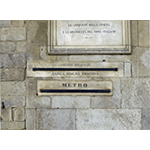Palazzo Comunale di Pistoia [Town Hall of Pistoia]
Before the French Revolution, every city, even within the same state, adopted its own units of measurement. As of 1791, a new unit of length was proposed in France, called the metre. As of the 19th century, the use of this system (the decimal metric system) progressively spread to vast areas. In this context, considerable importance is assumed by the plaques comparing the various units of measurement that were usually placed on the facades of public buildings. The portico of the Town Hall of Pistoia presents an example that compares the Florentine arm to the metre.
This building was also the headquarters of old scientific gatherings. The Main Hall hosted the meetings of the Pistoian Academy of Sciences, Letters and Arts from 1803 (year the Academy was founded) to 1811, year in which Napoleon gave the academicians the premises of the suppressed convent of Santa Maria del Carmine of Pistoia. The Academy was born with the name of Academy of Various Literatures, by initiative of several teachers of the Fonteguerri College and eminent personalities of the city. The members promoted literary, historical, philosophical, social and scientific studies with a preference, in the early years, for the physical and mathematical sciences. Later, under the influence of the studies of economy promoted by the Accademia dei Georgofili, problems tied to economy and agriculture were also discussed. In 1813, four classes were formed: Moral Sciences, Mathematical and Physical Sciences, Economic Sciences, Literature and Fine Arts. It was closed from 1831 to 1838 as a preventive measure against the political disorders tied to the Risorgimento climate. At its reopening, it participated with numerous delegations in the Congresses of Italian Scientists, and organised artistic, industrial and agricultural exhibitions for the Pistoian territory. In 1891, it ceased all activity.
In 1821, in the ambit of the Pistoian Academy, the "Societą dei Parentali ai grandi italiani" [Parentalia Society to Great Italians] was born, the first in Italy, which ideally evoked the ancient Parentalia celebrated by the Romans. The Pistoian celebrations, held at the expense of the Society, were hosted in the classrooms of Forteguerri College or in the main salon of Town Hall. Among the various figures commemorated, we must also indicate men of science like Galileo Galilei and Filippo Pacini. The Society ceased activity as of 1857, but the celebrations continued until 1885 with the sole support of the Pistoian Academy of Sciences, Letters and Arts.
****************************
Texts by Graziano Magrini
English translation by Victor Beard
Last update 19/ago/2008




